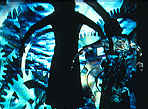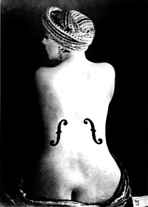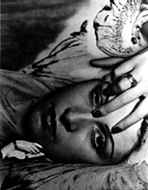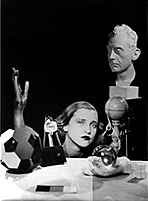
|
|
Nov. 26, 1996
|
Art Watch Index - Nov. 5, 1996
![]()
|
"KusaMeikyu", the Japan-Hong Kong Dance Theatre Collaboration by Pappa Tarahumara and Zuni Icosahedron
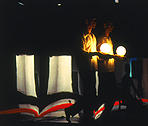
"KusaMeikyu"
Zuni Icosahedron http://www.freeway.org.hk/ zuni/
NOH MASK
NOH MASK EXHIBITION
Kabuki Ukiyoe Gallery(in Japanese)
UKIYOE GALLERY
UKIYOE HOMEPAGE
Ukiyo-e museum Edo Trip
|
Post-colonialism and Colonialism That Meet and Pass Each Other
A reflection, or the situation of the artist "One must not walk through the surface of the mirror. Remain in front of it." While watching "KusaMeikyu", a theatre collaboration by Zuni Icosahedron from Hong Kong, and Pappa Tarahumara from Japan (directed in collaboration by Danny Yung and Hiroshi KOIKE), it reminded me of these paradoxical words by the Polish director, Tedeusz Kantor. The following comment was written about "Kusa Meikyu", written by Kyoka IZUMI - "When he was a small child, his deceased mother used to sing him a nursery song. Once again, he wanted to hear that nostaligic song, which recurred in his mind. Carrying the memories of his mother, a young man wanders, searching for a song, and the place he arrives at is an abandoned mansion where a beautiful woman lives, protected by a monstrous creature." (Taken from Iwanami Bunko). The attempt of a company, composed of artists from Hong Kong and Japan, to create a new image utilizing the literary work's concept, could not avoid creating a strangely paradoxical situation. The reversed labyrinthian world The main set of the central stage is a wall. That wall is pierced with a door and a window (this sometimes becomes a painting or a mirror). On the other side of the wall, there is a mirrored wall which slightly wavers, and the two walls are bridged with a stage which looks like a corridor. We, the audience, sit on both sides of the corridor, and the set is a space structured as if to hint the labyrinthian world of the abandoned mansion of Kyoka. Soon, we come to know that the space indicates both the inside and outside of the mansion, creating a reversed labyrinthian world. The post-colonial gesture However, when one poses the question of how the inside and the outside are organized, I could not help but be amazed that this scene looked as if the post-colonial vision of Danny Yung and the colonial vision of Hiroshi KOIKE were juxtaposed. There, I could not avoid feeling the unhealed blockage of the Japanese theatre. The abstractness of the bodies of Zuni's performers, and the conceptual impression which their movements created, clearly seemed to respond to the situation in which Hong Kong is currently placed. In other words, the views towards the future of the people in Hong Kong, facing the return of their land to China very soon, are specifically repeated in the physical gestures. They stand in front of the door, trying to look into the other side. They also lean forward to look into the darkness on the other side from the window, and squint their eyes. What do they see? The gestures of Zuni's performers expressed that they were not able to see anything definite. On the other hand, the performers of Pappa Tarahumara present an answer, as if to question why we cannot see such a thing. Certainly, it is not necessary for such a scheme to be criticized. However, surprisingly, what these performers indicated was an image of a world which could be described as a "beautiful Japan". There were nursery rhymes sung, spheres of light that danced in the labyrinth, an appearance of a woman who was like a goddess, and on the wall, projections of Noh masks and Ukiyoe. Many of these things are offered to us from the spiral-structured labyrinth of Kyoka, but when they are placed in a structure where on the outside, there is the historical current situation of Hong Kong, and on the inside, the traditional scenery of Japan, together with the colonialistic gesture, they appear to self-affirm "what is Japanese". The dream of regression and the Japanese body What Kyoka expressed in his work was a dream of regression. Tatsuhiko Shibusawa had said that a type of transcendency, in other words, what should be called the "negative transcendency" is expressed paradoxically in such a dream. However, when that is placed in a colonial scenery, as in this production, such a paradoxical transcendency is impossible to happen. While watching "KusaMeikyu", I felt a large potential in the artistic attitudes seen in the gestures of Zuni's performers, who had nothing to do with the colonialistic bodies of the Japanese, adamantly staying on this side of the door and window. At that moment, I remembered the words by Kantor. "Remain in front of it!" With Zuni's performers remaining on the outside, they were able to maintain a post-colonialistic vision, which also indicated simultaneously, the difficulty for a post-colonial view to turn its eyes towards the inside. [Hidenaga OOTORI/Theater Critic]
|
|
|
|
<<Man Ray Photography Exhibition 1917-75>>
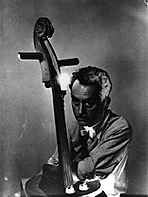
Autoportrait solarisée avec lamp
Le Violon d'Ingres
Dora Marr solarisée
Essai tiré en noir et blanc d'après une plaque
couleur pour la couverture de album Man Ray Photographies
1920-1934 Paris
Photos: ASSOCIATION INTERNATIONALE DES AMIS ET DEFENSEURS DE
L'OEUVRE DE MAN RAY
MAN RAY The Department of Objects and Delusions http://pharmdec.wustl.edu/ juju/surr/images/ surr-imagery.html#ray
Man Ray - Reference Page
Man Ray, Rayograph
The Surrealism Server
Marcel Duchamp and Redaymade
Marcel Duchamp - Reference Page
|
Airy Eroticism
Photography as magic Man Ray (1890-1976) is an artist, who cannot be simply classified as a photographer. His footprints are imprinted in almost all realms of modern art, from art objects (famous for their cynicism and esprit) to woodprints, drawings and even cinemas. This artist, who is just like a naughty child grown big, crossed various realms in light, airy footsteps. However, as his name "Man Ray" implies (his real name was Emmanuel Rudnitzky), photography must have been his most beloved expressive medium. Already, from his New York days, Man Ray had been involved in photography, taking pictures of his own art objects or paintings. When he moved to Paris in 1921, also in order to earn his living, he started to work as a professional photographer. Here also, he did not limit his photography to one realm, but took portraits, nude photography, and fashion photography, and to prove his best ability as a "ray-man" he left many versatile works in experimental photography, such as rayograph (photogram), and solarization. Man Ray was fascinated by photography probably because this was a magical medium which allowed him to put ideas and inspirations immediately into a fixed form. Another reason was because he accepted the concept of chance and extempore, which is the basic principle of surrealism. He was not the type of artist to stay in one place and carefully develop his work, thus he adopted a style where he quickly realized his ideas which came to him one after another. Photography was the ideal medium for his work, because as long as he clicked the shutter, the images present before him automatically became fixed. In every one of Man Ray's photographs, one can feel the path of his vision, and his attempts to quickly pick up and organize the fragments of the changing and flowing world. The multi-dimensional exhibition structure In the <<Man Ray Photography Exhibition 1917-75>> (Tokyo Station Gallery from September 14 to October 20, 1996. Tour exhibition in Osaka and Kyoto), there is a structure in which his total picture as a photographer was categorized into 9 parts. The 9 parts, "Self-portraits and ateliers", "Women", "Friends", "Portraits", "Nudes", "Dada and Surrealism", "New York/Paris", "Mode and Publication" and "Marcel Duchamp", shed light on the multi-faceted and multi-dimensional aspect of Man Ray as a photographer, from their respective angles. What is especially highlighted in this exhibition is not only the modern prints newly printed from the remaining negatiaves, but also the fact that there were many vintage prints (prints made soon after the shooting) printed by himself. Some of these had his own hand writing and instructions for trimming, which allowed us to trace the process of how his thought movements became established as images. What was more interesting was the vivid communication between him and the characters in the photographs, typically shown in the "Marcel Duchamp" section, and in the picture, "Vacance 1937", exhibited as a reference exhibit. For Man Ray, photography meant more than just a solitary work of freezing his images onto the frame. It was probably a collaborative process in which he worked on his subjects, and actively incorporated their reactions into the works. The series of photographs where his performances, such as dressing up as a woman, shaving the back of his head in a star shape, and covering his face in bubbles, were recorded, indicate the mutually stimulating relationship between Man Ray and his subjects. Such a relationship, in which unexpected reactions from the subjects were drawn out, could be described as erotic in the true sense of the word. In Man Ray's photographs, both the photographer and the subjects can be said to be truly enjoying the airy, but indulging vibration of eroticism. [Kohtaro Iizawa/Photography Critic]
|
|
|
|
|
|
|
|
|
Nov. 26, 1996
|
[home]/[Art Information]/[Column]
Copyright (c) Dai Nippon Printing Co., Ltd. 1996
Network Museum & Magazine Project / nmp@nt.cio.dnp.co.jp
